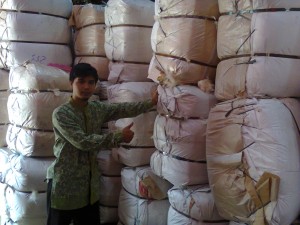Kapok fiber is one of the natural fiber that grows cellulostic on cotton crops . It has a hollow body and tail sealed , which is a desirable feature of this natural candidates for functional textiles . However , low volume weight of kapok is ( specific density 0.29g/cm3 ) , and the short length of the fiber and the smooth surface , causing poor cohesion between the fibers , has been prevented from being processed by the cotton spinning machine modern .
Kapok is a soft fiber clothing ceiba trees of the family Bombacaseae . Kapok fiber has the rich oiliness and does not have a high strength and , because it can not be spun economically . It is conventionally used as a stuffing , especially for float , blankets , and upholstery , and insulation against sound and heat .
The Kapok fiber has a hollow structure with an external radius of approximately 8.25 ( ± 4 ) _m , a diameter of about 7.25 ( ± 4 ) _m , and a length of about 25 ( ± 5 ) mm . Combined with the specific material density of 1.3 g/cm3 , a large pore volume in Kapok Napl assembly available for absorption . Typical analysis shows that the Kapok fiber consisting of 64 % cellulose , 13 % lignin and pentosan 23 % . In addition to these constituents , they also contain cutin wax on the fiber surface which makes them waterproof with their stand preponderantly composed of cellulose .
Versatile Applications of Kapok Fiber: From Life-Saving Equipment to Insulation Materials
Kapok find use in bed and coatings industry , in the production of life -saving equipment , and the construction of thermally insulated and soundproof blankets and walls . On account of buoyancy , freedom from water capacity – logging and weight-bearing , it is the material par excellence for the manufacture of lifebuoys and belts , vests and life-saving equipment other navies . Buoyancy of cotton is about five times as large as that of cork and about three times that of deer hair . During the war , cotton is used for the isolation tank , to layer clothes flying , to fill the float army attack – the bridge , and generally to replace the cork in any light , moisture – resistant and buoyancy needed .
Kapok fiber has been used in a flotation vest and has been used as building insulation has a hollow fiber and glass fiber looks like under a microscope . Hollow fibers allow the air inside has a burning deep inside the material . Smoldering fires and open flames travel quickly in the material .
Benefits and Advantages of Kapok Fiber: A Natural, Eco-Friendly, and Antimicrobial Material
The Kapok tree is a deciduous tree that can be found in the forests of Asia and Central America .
It grows up to 70m and has a fruit capsule , which was taken and opened by hand .
Ber of fiber fruit – dried and not treated with chemicals .
Kapok is a natural fiber that is completely biodegradable .
Bitter constituent of natural Kapok fiber is anti – bacterial and anti – microbial therefore
Moths, mites and other microorganisms can not occupy a toy
Contact us :
☎️ : +6285933133244
📍 : Jl.Ir Soekarno, No.122, Dadaprejo, Junrejo, Kota Batu, East Java 65323


